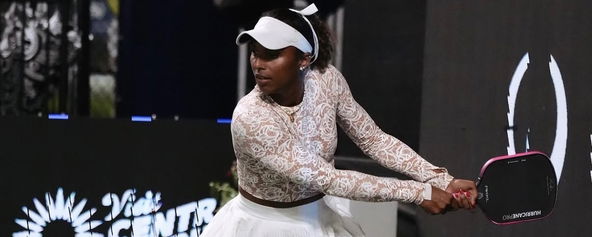
Pickleball Elbow: Treament & Prevention
DALLAS, TX – There are few things worse for a pickleball addict than getting a bad case of pickleball or tennis elbow.
There's no easy fix for the condition that can potentially sideline you for nine to 12 months.
Also known as lateral epicondylitis, tennis elbow is the swelling or tearing of tendons in the arm caused by repetitive motion of the forearm muscles.
Florida-based orthopedic surgeon, Dr. Jon Radnothy, provided some insight on the dreaded ailment.
“This is just what happens as we get older. Our tendons, like everything else, start to wear down. They don’t have the same resiliency, the same strength, and the same elasticity they used to when you’re younger. Things get irritated easier,” explained Dr. Radnothy, who has been practicing medicine for 34 years.
“Tennis elbow pain can get progressively worse to the point where you’re not only having soreness and pain on the outside of your elbow, but it can cause big-time throbbing and achiness. Even when you’re not using it, your whole upper extremity can bother you from your elbow up to you shoulder, down into your forearm and wrist,” he added.
Dr. Radnothy clarified that the pain from tennis elbow is not a numbness or tingling. In fact, it is commonly mistaken for carpal tunnel syndrome or arthritis. In short, tennis elbow is a tendon problem that results when the tendon has been overused.
ADVERTISEMENT
“The number one thing is resting and backing off the activity that brings it out,” he advised.

That basically means play less pickleball.
Talk about a truly heartbreaking thing to hear when America's fastest-growing sport has become your life. Play less pickleball? That’s the worst kind of treatment plan.
Fortunately, there are other ways to faciliate recovery and prevention.
“Do some stretching and exercises for those tendons. Get a good physical therapist or occupational therapist who can help you develop a program that can help recondition those tendons, so when you do stuff like playing pickleball or tennis, it’s not as likely to come back and bother you,” shared Dr. Radnothy.
He also provided some key strategies to relieve the pain associated with tennis elbow.
“You can try anti-inflammatory medications, everything from the over-the-counter anti-inflammatories to the prescription ones that your physician, physician assistant, or nurse practitioner can prescribe for you,” mentioned Dr. Radnothy.
“You can also wear a tennis elbow strap. In theory, that will relieve some of the stress in the tendon. Sometimes those work, sometimes they don’t. People have tried all kinds of liniments, rubs and oil that you can put over your elbow. You can get an occasional cortisone shot that can sometimes help,” he continued.
Oftentimes, people will continue to engage in the activity that aggravated the tendon in the first place - like playing pickleball - at the same pace, intensity, and frequency.
Dr. Radnothy cautioned against this.
“If you’re doing the activity that has exacerbated this or caused this initially, and you don’t properly rest it and don’t get good reconditioning of those muscles and the tendon, then it can come back and continue to bother you,” he noted.
“It comes down to age. You’re pushing your body well beyond what it’s supposed to be pushed right now. If you overdo it, then you get elbow problems. The number one thing I tell people is that you gotta back off your activities and let it rest,” he added.

The veteran practitioner has personally dealt with tennis elbow before.
“Man, it was rough,” revealed Dr. Radnothy. “It lasted a good nine months. I still have to be conscientious because I can tell if I overdo it. If I go in the yard and I’m weeding or doing something that’s repetitive, and I feel it coming on, I have to back off.”
As for why some people get tennis elbow and others don't...
“I think some people are just predisposed to get these tendon inflammatory conditions, just like we’re all predisposed to whatever our biological parents give us,” explained Dr. Radnothy. “Some people’s tendons just get inflamed easier.”
There are several strategies on the court that can help relieve tendon pain, like changing your grip or the thickness of your paddle’s handle.
Commenters on the Pickleball Facebook Forum shared specific paddles that can deliver pain relief, but take any recommendations with a grain of salt.
Follow your doctor’s advice first.
“They’re all attempts to get this thing better while still allowing you to continue playing at the same pace, the same intensity, and for the same duration that caused it in the first place. That’s why resting is most important,” concluded Dr. Radnothy.
Related articles

Thomas Wilson reflects on faith journey: 'What we’ve gone through has brought our entire family closer together'
Navigating a host of challenges has brought valuable perspective and deeper meaning to his life.
8 days ago
-Victoria Radnothy

In defense of ELN’s picnic table blanket dress
People didn't hesitate to share their opinions, including a certain podcaster.
11 days ago
-Victoria Radnothy

Best dressed at the Veolia Lakeland Open presented by Six Zero
The fashion choices in Florida were simply elite.
20 days ago
-Victoria Radnothy

Michelle McMahon reflects on acting experience in 'A House of Dynamite'
The Pickleballtv star played a reporter in the popular Netflix movie.
24 days ago
-Victoria Radnothy





